

Time To Upgrade: DDR SDRAM, Athlon XP Are Worth It
By Joel Hruska and Van Smith
Date: November 9, 2001
Back when DDR SDRAM chipsets were first becoming available there was a lot of questioning as to whether a mature SDRAM system such as the VIA KT133A or new DDR SDRAM platform was a better choice. Mediocre performance from the A0 stepping of the ALi MAGiK 1 and the VIA KT266 certainly didn’t help matters. Because of this, many DDR SDRAM adopters choose AMD's 760 chipset.
 Part of DDR SDRAM's initial trouble gaining
traction was the availability of high-performance SDRAM solutions that often
came within just a few percentage points of DDR SDRAM performance while backed
by cheap, stable, full-featured, and powerful boards. Namely, the VIA KT133A
chipset was a huge success that facilitated 266 MHz FSB (Front Side Bus -- the
part of the CPU that speaks to the world; this is opposed to Back Side Bus which
is used to interface with high speed cache memory) AMD Athlon processors while
allowing the use of the older, cheaper and more plentiful SDRAM standard.
Part of DDR SDRAM's initial trouble gaining
traction was the availability of high-performance SDRAM solutions that often
came within just a few percentage points of DDR SDRAM performance while backed
by cheap, stable, full-featured, and powerful boards. Namely, the VIA KT133A
chipset was a huge success that facilitated 266 MHz FSB (Front Side Bus -- the
part of the CPU that speaks to the world; this is opposed to Back Side Bus which
is used to interface with high speed cache memory) AMD Athlon processors while
allowing the use of the older, cheaper and more plentiful SDRAM standard.
 In less than a year, the DDR SDRAM platform has
rapidly matured in the last year however. ALi has
refined its chipset design with the B0 stepping
of the
MAGiK 1
platform increasing performance over the earlier
versions of this chipset. SiS has offered their high performance and
affordable
SiS735 single chip solution and the nForce is finally very close to
making its debut. Lastly, we have the KT266A from VIA. The VIA KT266A, a leap
beyond the KT266, is the highest performing DDR SDRAM chipset available today
(arguably tied with nForce, but nForce has yet to establish a retail
presence, while KT266A boards are shipping and
cheap).
In less than a year, the DDR SDRAM platform has
rapidly matured in the last year however. ALi has
refined its chipset design with the B0 stepping
of the
MAGiK 1
platform increasing performance over the earlier
versions of this chipset. SiS has offered their high performance and
affordable
SiS735 single chip solution and the nForce is finally very close to
making its debut. Lastly, we have the KT266A from VIA. The VIA KT266A, a leap
beyond the KT266, is the highest performing DDR SDRAM chipset available today
(arguably tied with nForce, but nForce has yet to establish a retail
presence, while KT266A boards are shipping and
cheap).
We decided to take another look at the DDR SDRAM versus SDRAM question now that more mature DDR platforms are available. We also take a peek at a few tests showing the significant advancement the Athlon XP is, and how this chip is better suited for DDR SDRAM than its predecessor.
For comparison we chose motherboards from two of the top manufacturers. The MSI K7T Turbo2 represents the VIA KT133A SDRAM board, while the Epox 8KHA+ is our VIA KT266A DDR SDRAM test bed.
===================================
The MSI K7T Turbo2
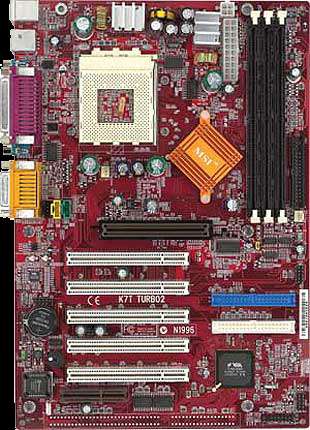
The MSI K7T Turbo2
uses the VIA KT133A.
The MSI K7T Turbo2 is a great example of a budget VIA KT133A motherboard done right. The PCB is a striking red color and features five PCI slots, one of which is shared with a CNR slot. The tiny CNR slot can be used for telephony, networking or five-channel audio, but unless a CNR card is bundled, the slot is essentially useless. We are still awaiting widespread adoption of ACR, a much more flexible riser card standard which should be kick-started with the appearance of nForce motherboards.
The five PCI slots provide plenty of expansion room. The three DIMM slots are easy to access and populating all three banks does not interfere with inserting the AGP card as much as on some other motherboards. The Universal AGP card slot has a rear latch to secure the card in place.
Onboard audio is supported through the KT133A southbridge's AC’97. The southbridge, the VIA 686B, also features dual ATA100 controllers and a floppy controller.
The Award BIOS is full-featured and supports a wide array of RAM settings and CPU multiplier/voltage/FSB tweaks. Our board also proved to be a stable overclocker and ran at a 160 MHz FSB (320 MHz DDR) without incidents. Provided your RAM, AGP, and PCI cards can handle the speed, the board overclocks well. As always, MSI does not officially condone or support overclocking their equipment.
The motherboard is compact and would fit well in any mid-tower, even one cramped for space.
All in all, the MSI K7T Turbo2 is a solid, full-featured, motherboard design. While it lacks “exciting” features like onboard RAID or a hardware sound solution, the motherboard can be purchased for as little as $85 on Price Watch making it a budget solution that won’t break the bank. My only complaint about the board is that some of its capacitors are excessively large [ed: but, on the other hand, numerous big capacitors are usually a sign of quality] and may block certain heatsinks. However, we had no problems with either the AMD OEM standard heatsink or the Thermaltake SK6.
===================================
The EPOX 8KHA+
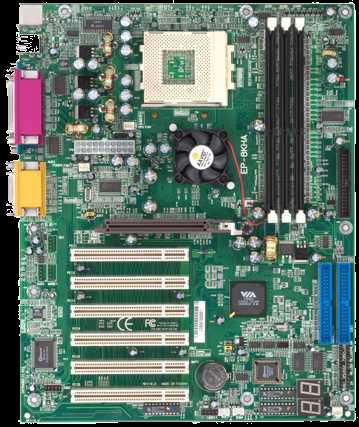
The EPOX 8KHA+ features the
VIA KT266A
The EPOX 8KHA+ is one of the first KT266A motherboards out of the gate and is clearly aimed at a higher market price than the more budget-minded K7T Turbo2. The EPOX board delivers a full six PCI slots, while also providing AC’97 sound support through the VIA 686B Southbridge.
One feature of the 8KHA+ that was quite nice was its onboard digital LED display [ed: this is like having a diagnostic POST card built-in -- very handy]. The MSI board offers a similar option via an add-in adapter. The onboard display on the 8KHA+ reports the series of codes as the machine performs its preoperational system test. In the event of a lock-up, the manual lists of the error codes definitions. This is much easier than the older POST code method, since it eliminates deciphering beep codes that vary between different BIOS manufacturers.
We initially encountered problems with the Epox board. The system would hang when installing Windows XP while using a GeForce3 card, but a BIOS flash corrected the problem. Other than these initial setbacks, we had no difficulty with the board at all.
The VIA KT266A chipset featured in the Epox board is currently the highest-performing Socket A core logic solution available. For an excellent in-depth guide to it, check out the review at Lost Circuits.
===================================
Configuration Notes
Both machines were configured as follows:
When building these platforms we had to make a judgment call on the configuration. It is highly unlikely that a prospective buyer would be able to spring for both a GeForce3 and Athlon1800+, only to use an SDRAM chipset. Its also true that the two motherboards in question are aimed at different markets. Nevertheless, in order to make a proper comparison between the two platforms, we were obliged to use an identical hardware configuration in each.
===================================
Memory Subsystem Tests: The Athlon XP Excels
Although this has not been effectively discussed, the AMD Athlon XP represents a significant advancement beyond the Thunderbird Athlon especially in regards to memory subsystem performance.
One new feature of the Athlon XP that obviously impacts memory bandwidth is hardware data prefetching. Surprisingly effective, the Athlon XP's hardware data prefetch engine is sometimes able to extract considerably more bandwidth out of PC133 SDRAM than the old Athlon could deliver from PC2100 DDR SDRAM.
VHJ has been working on a number of open source benchmarks to help jumpstart COSBI. One of our first tests we call "BandwidthBurn." The BandwidthBurn graph below shows, from left to right the bandwidth of the L1 cache up to 64kB. Because of the Athlon's exclusive cache architecture, the L2 cache bandwidth starts at 64kB and stretches 256kB to the 320kB mark -- in an inclusive cache structure as used in Intel chips, the L2 would end at 256kB.
Beyond the 320kB mark is the bandwidth of main memory and is what we need to pay particular attention to.

Combined read/write bandwidth versus dataset size
Note that the XP-SDRAM platform easily outpaces the 1.4 GHz Athlon-AMD761 PC2100 system. Also note that the KT266A significantly betters the AMD761.
Amazingly, the sustainable bandwidth of the Athlon XP 1800+ KT266A system approaches the L2 cache performance of the 1 GHz Thunderbird Athlon.
===================================
Memory Latency: The Athlon XP Screams
Another developing COSBI test is MemLatency. This benchmark copies random elements from a source array to random elements of a target array which should undermine stride predictors and give a good idea of relative latency characteristics. The dataset size is then gradually increased and the results are reported in assignments per second so that higher is better.
The first graph below shows the entire range of the test. What is immediately evident is how well all Athlons perform relative to the Pentium 4 as long as the dataset resides in cache.
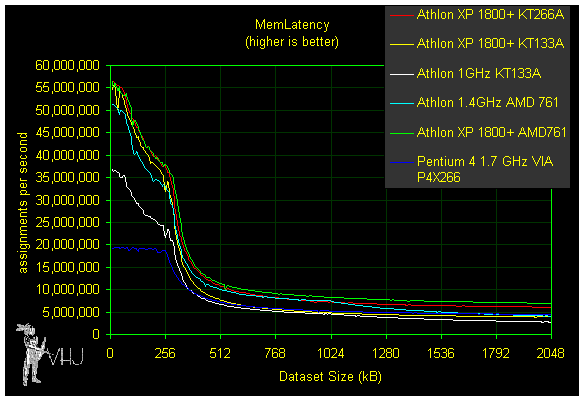
This second graph below is a blowup of the cache regions plus a little main memory.
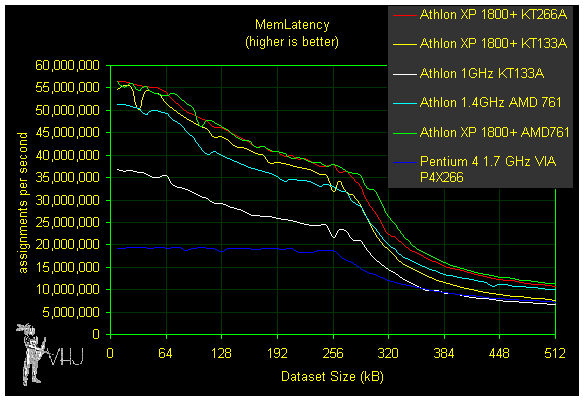
The next graph shows the most important region to look at for main memory performance. Prior to the Athlon XP, AMD's Athlon family had very poor memory latency characteristics. Looking at the graph below, it appears that the KT133A also played some part in this poor showing. Now, however, both DDR SDRAM Athlon platforms perform quite strongly and, when coupled with the Athlon XP, beat the Pentium 4 by wide margins.
If you are wondering how DDR SDRAM memory latency performance is trouncing SDRAM's performance, it is important to remember that a cache line has to be filled on all misses -- which occur effectively every assignment for large datasets in this test. DDR SDRAM can fill the cache line roughly twice as fast as SDRAM.

The final graph below illustrates the profound latency improvement that the Athlon XP delivers. Taken with an 8 MB dataset, this neutralizes the cache effects and gives a good idea of main memory latency performance. Note in this graph that time is being reported so shorter is better. Also notice that the KT266A and AMD761 are performing identically.
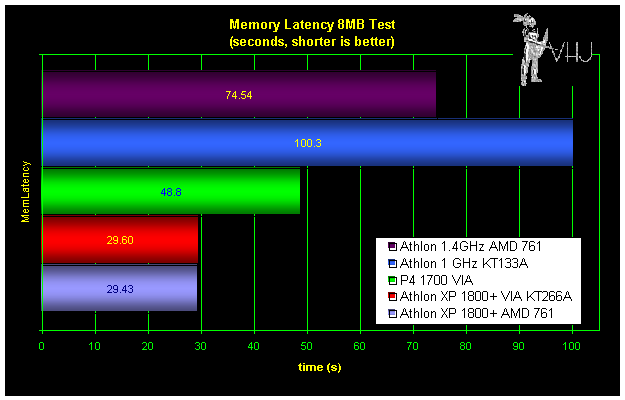
===================================
Sysmark 2001, Office Performance
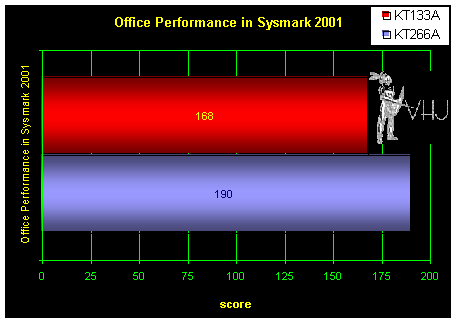
In the SysMark 2001 Office Performance test we see the KT266A jump ahead by a surprising margin. Although the KT133A turns in a respectable 168, the KT266A beats it by a whopping 13%!
This level of bandwidth dependency is very unexpected in an office application level benchmark and may indicate that this test has been tweaked by BAPCo to show the Pentium 4 in a more favorable light.
===================================
3DMark 2001: 1024x768x32
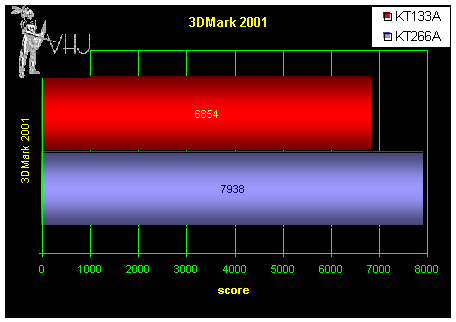
In 3DMark 2001 we see the DDR platform pull ahead of its older cousin by 16%. Complex 3D calculations are innately more bandwidth intensive than typical office applications.
===================================
3DMark 2000: 1024x768x32
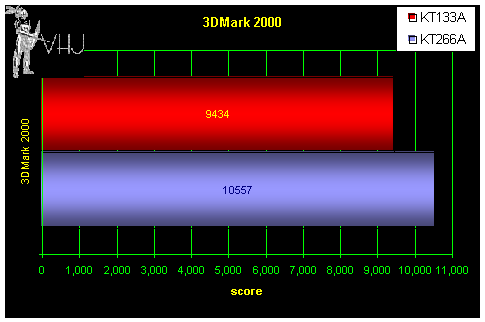
In 3DMark 2000 we see the KT266A leading by only 12%. Some suggest that games are becoming increasingly more bandwidth intensive. If so, the differences between DDR SDRAM and SDRAM will become clearer with time. Nevertheless, both platforms turn in high scores, and either would be suited for 3D gaming for games of this era—more than suited, in fact.
It is interesting to note here that 3DMark 2001 is 25% more bandwidth sensitive than 3DMark 2000. We must note that MadOnion, the producers of 3dMark, and BAPCo are affiliated.
===================================
Quake 3 Arena: 1024x768x32, Max Detail (Demo 4 used)
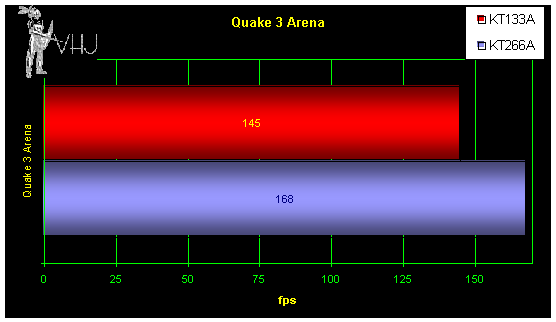
In Quake 3 we see the KT266A pulling ahead of the KT133A by 16%. This is not surprising, since this game is recognized for being highly memory-bandwidth sensitive.
===================================
Max Payne: 1024x768x32, Hardware T&L, Detail Maxed)
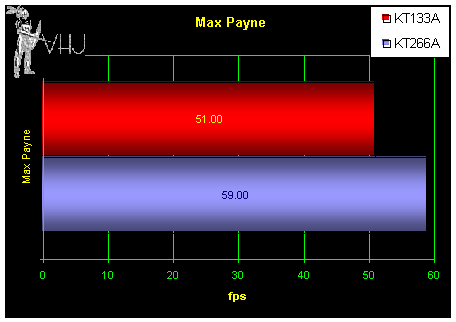
In Max Payne we again see the KT266A outperforming the KT133A by 16%.
===================================
Serious Sam: 1024x768x32

In Serious Sam we see the KT266A pulling ahead by its largest margin yet. Here it leads the KT133A by a huge 19%. This again shows the speed increase that DDR brings to certain modern games and applications.
Curiously, as Quake III is usually considered a Pentium 4 friendly benchmark, Serious Sam is often regarded as favoring Athlons. Despite this, Serious Sam appears to be one of the most bandwidth sensitive tests around, which would normally help the Pentium 4 to at least perform on par with the Athlon.
===================================
Miscellaneous Tests
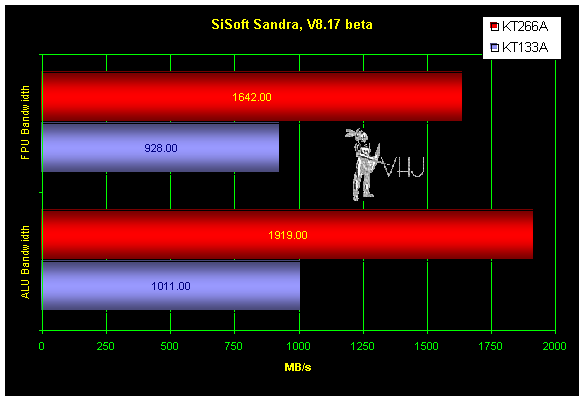
Our final test is SiSoftware Sandra memory bandwidth benchmark. This particular synthetic evaluation probably approaches the maximum performance delta that we can expect from any bandwidth heavy task -- and the difference is huge with DDR SDRAM almost doubling SDRAM's bandwidth. This version of SiSoftware Sandra has specific Athlon streaming optimizations although the FPU test is somewhat deficient.
===================================
The FSAA Twist: Anti-Aliasing with the GeForce 3
Not long after the Voodoo5 came out, Anandtech took a look at FSAA on the Voodoo5 when paired with older / slower CPU’s and discovered that a bump up to 2x FSAA could essentially be had “for free” due to the extra video overhead.
We decided to take a look at the GeForce3 when anti-aliasing capabilities were enabled, and see whether or not the same held true for it. How much does enabling FSAA equalize the performance of the two platforms?

Here we see something very interesting. As the FSAA level of the GeForce3 rises, the performance difference between the two platforms becomes smaller, until it finally vanishes at 4x FSAA. While this is unimportant for the gamer who emphasizes speed above all else, for gamers who value image quality but are using SDRAM, it answers an important question about the worth of a GeForce3. A GeForce3 running at 4x FSAA will perform nearly identically on either an SDRAM or DDR SDRAM motherboard, and keep in mind, even while running in 4x FSAA, the card is capable of pushing Quake 3 at 80 frames a second in 1024x768x32, a frame rate which is quite playable, to say the least.
If you are an FSAA-lover who’s been considering a GF3 upgrade, but aren’t sure the card will enhance your gaming experience you need to think again. In 1024x768x32, the GF3 delivers an excellent gaming experience even with 4xFSAA enabled on an SDR motherboard.
Keep in mind, however, that if you aren’t an FSAA-user, there is some evidence (unearthed over at Aceshardware) that a GF3 is actually slower than a GF2 when paired with an SDR motherboard. I only recommend a GF3 if you favor image quality over sheer speed, and FSAA over non-FSAA.
===================================
Conclusion
The evidence is clear. The maturing DDR SDRAM VIA KT266A platform decisively outperforms SDRAM and the VIA KT133A chipset. Also clear is the fact that the Athlon XP is generally much better able to utilize the extra memory bandwidth while also greatly reducing memory latencies. This double-whammy makes upgrading to an Athlon XP-KT266A DDR SDRAM system compelling.
The KT133A chipset still has several strong points going for it, however. As cheap as RAM has gotten in the last few months, there are still those people who need powerful levels of computing performance but cannot afford to invest in new RAM. For those people looking to upgrade and use their existing RAM, the KT133A remains a great choice. Furthermore, the platform itself is cheaper: the MSI K7Turbo2 is available for as little as $85 [ed: note that SiS735 based DDR SDRAM motherboards can be had for $60 or less] according to Price Watch, while the Epox 8KHA+ is about $20-$30 more. And the Athlon XP is often able to bring memory performance of an SDRAM platform above what a Thunderbird Athlon could deliver from DDR SDRAM.
The KT133A still offers good performance in bandwidth sensitive gaming as well as in professional work involving memory streaming. The KT133A remains a decent performer when paired when a mid-to-high end graphics card.
In the end, what we have here are two different platforms that are well-suited for the market segments they are positioned for. The K7T Turbo2 is a budget-oriented, stable, and effective motherboard that offers continued support for SDRAM as well as the AthlonXP. The Epox 8KHA+, on the other hand, is a more expensive board with a greater feature set and higher performance. In the end, both are excellent products, and I would recommend either depending on your needs and budgetary considerations.
But for most of our readers, the choice is clear. It’s time for DDR SDRAM, preferably taken along with an Athlon XP. The upgrade cost is modest while the performance delta between SDRAM and DDR SDRAM -- especially with an Athlon XP -- has become significant. Saying that, the Epox 8KHA+ is a good choice.
===================================
Pssst! Our Shopping Page has been updated.
===================================